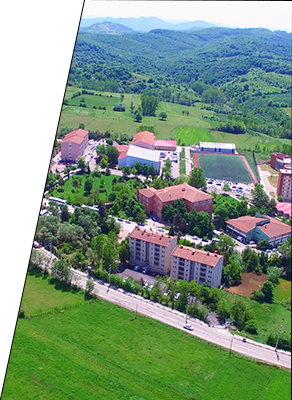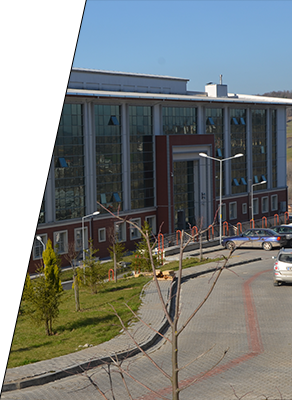About Bartın
General Information
The province of Bartın, which is located in the Western Black Sea Region, is surrounded by the Black Sea with 59 km of coastline in the north, Kastamonu in the east, Karabük in the east and south and Zonguldak in the west. Bartın is surrounded by mountains, which are noth higher than 2000 m, in the east, west and in the north. The mountains are quite steep and rocky towards the shore, but not very high. The highest point is Keçikıran Hill (1619 m). The most important mountains of the region are Aladağ, Kocadağ, Montenegro, Kayaardı, Karasu and Arıt. The city center is surrounded by Aladağ in the west, Karasu in the north, and Arıt in the east. The land is very rugged, because it is severely broken down by Bartın River and its headwaters. Between the steep slopes of the mountains and where the river extends, there are narrow and deep valleys. As you come down to the city centers, the number of flat plains increases.
The most important stream of Bartın is the Bartın River, which is named Parthenios in Antiquity, and gives its name to the city. The two main headwaters of Bartın River, Kocaçay and Kocanazçayı, merge in Gazhane Burnu at the center of Bartın and reach the Black Sea at the Bosphorus. Kocanazçayı is born in the south and flows to the north of Kozcağız. Kocaçay, which is 107 km long, consists of Göksu and Eldeş Brooks (Ulus Brook), which flow from Kastamonu to Ulus, and other brooks, which join these. Akpınar and Karaçay Streams together with the Kışla Stream, which joins the Kozlu Brook consisting of Arıt and Mevren Streams, feed Kocaçay. Kapısuyu and Tekkeönü Streams and Ovaçayı and İnönü Streams, which irrigate Ulus-Uluyayla, are other important rivers.
Bartın’s surface area is 2143 km2 and its elevation from the sea level is 25 m. The city’s total population is 184.178.
The city’s economy is based on agriculture, animal breeding and forestry. Agriculture products grown in the region are wheat, barley, corn, oats, beans, sunflower, onion, potato, clover and vetch. Greenhousing has developed in the recent years. Forests cover 46% of Bartın’s 2,140 km2 land area. For a long time the city’s forests have been one of the main sectors of the economy. It is found in the historical records, that lumbering activity started in 1402, when the Ottoman Empire attempted to establish Gelibolu shipyard, the galleys and galleons of the Ottoman Empire were made in in the shipyards of Bartın, Amasra and Kurucaşile, and that lumber was transported from Bartın to the Alexandria Harbour of Egypt in order to strenghten the Suez Canal, in 1914. The forests of the city, consist of bay, oak, beech and arbutas up to 600 meters, beech and hornbeam up to 1000-1500 meters and beech, chestnut and pine trees in the higher zones. The city’s forests are operated by two different operation directorates, which are in the centre of Bartın and in Ulus province.
The name “Parthenia” comes from “Parthenios”, which was the the name of Bartın Stream in the antique age. Parthenios is the “Water God” in the antique age and one of the children of Okenus, that is the the Father of Gods in the Greek mythology. The city of Parthenia was founded on the edge of Bartın River, which was called Parthenios in the antiquity, and it turned eventually from Parthenia to Bartın. In the end of the XIIth century B.C. , Bartın in Bithynia region was ruled by the Phrygians, and Amasra in the Paphlagonia region was ruled by the Phoenicians. The Phoenicians created their first colonies in Sesamos, Heraklia, Sinope and Kromna. Bartın and its surrounding were ruled by the Cimmerians in the VIIth century B.C, by the Lydians in the VIth century B.C, and by the Persians in 547 B.C.
In the 334 B.C. the King Alexander of Macedonia ended the domination of the Persians and became the owner of the region and gave tha management of Bartın and Ulus to General Eumenes. He gave the management of Amasra and Tekkeönü to the Governor of Phrygia. The Queen Amastris started to rule Amasra between the years 302 and 286 B.C. The city had been named Sesamos since XIIth century B.C. After the Queen Amastris period, which continued 16 years, the city was named after the queen. In this period, Amasra became the capital city of he Symoikismos Sites Union, which consists of Kromna, Tios and Kyteros.
In 286 B.C. the Queen Amastris was killed, when her sons scuttled the ship and Eumenes started to rule the city. Amasra and Bartın were ruled by the Kingdom of Pontus after the wars in the surroundings in 279 B.C. In 70 B.C. Romans, who came to Anatolia, ended the domination of the Kingdom of Pontus and started to rule the region. In the period of Romans, Bithynia and the section of the Kingdom of Pontus in Paphlagonia, became a state of Bithynia – Pontus, and were ruled by the General.
The Roman Empire ruled Bartın and its surroundings until 395 A.C. After the division of Rome and Byzantine, Byzantine ruled Bartın and its surroundings.
Bartın and its surroundings suffered from many pioneer attacks such as from Patzinaks and Cumans under the command of the Khazar ruler of in 390 B.C. from Arabs under the command of Abdulmelik in 798 A.C. from Seljuks in 800 A.C. and from Russians in 865 A.C. Kutalmışoğlu Süleyman Bey’s General Emir Karatigin invaded Sinop, Çankırı, Kastamonu and Zonguldak in 1804. He established a Turkish seigniory, which included Bartın, Ulus, Eflani, Safranbolu and Devrek. However, beause of Süleyman Bey’s death in 1086 and the First Crusades in 1096, Turks in Northwest Anatolia had serious problems. Following the agreement between Crusaders and Byzantine whole Black Sea coast including the region from İstanbul to Samsun, especially Amasra, Sinop and Ereğli were dominated again by the Byzantine.
Between 1460 and 1692 in the period of Ottomans’ domination, Bartın was located within the boundaries of Bolu Sanjak of the Governorship of Anatolia. Later on, the Governorship of Anatolia collapsed and Bartın was ruled between 1692 and 1811 with Voivodship. In 1811 Bolu Sanjak, bounded to Kastamonu province, was established again and started to rule Bartın.
In this period, Bartın became the market of the region thanks to its economic potential and was named Oniki Divan. In 1867 Bartın became a district. In 1920 Bartın was bounded to the lieutenant governor of Zonguldak. When Zonguldak became a province in 1924, Bartın became a district of this city. In 1991 Bartın became a province.
Historical artifacts of Bartın, which could be preserved until the present time are as following: the cavea and stage of the Roman theater in Amasra, ruins of the entrance door, wall remains of necropolis bouleuterion, ruins of acropolis walls, underground galleries, ruins of the Roman market, ruins of a Roman dock and jetty, the reclusion cave in Büyüktepe, ruins of a Byzantine church in Tavşan Adası, ruins of the castle in Tekkeönü Village, the Castle of Amasra, which belongs to the Byzantine period, castle ruins of the Genoese in Güzelcehisar, Şarköy and Fırınlı villages, which are between the boundaires of Merkez district, Fatih Mosque remained from the Ottoman period, İçkale Masjid, Halil Bey Mosque (Yukarı Mosque) (1872), İbrahimpaşa Mosque (Orta Mosque), Şadırvan Mosque (Aşağı Mosque) (1903-1905), Şimşirli Baba Mosque, Ebu Derde Mausoleum, which is told to be the monumental tomb of Ebu Derde, who is the flagbearer of the prophet, Aya Nikola Church (1319), and Amasra Küçüktepe Martyrum.
Also Taşhan (1832 – 1835), Dervişoğlu Public Houses (1897), ruins of Ottoman Bathhouse, Şehir Bathhouse (1447), Kemer Bridge (1872), Orduyeri (Kışla) Bridge (1887), Kemere Bridge of Byzantine period, Kemerdere Bridge of Roman period, houses and mansion ruins, which were built by using Ottoman civil architecture.





 History
History














